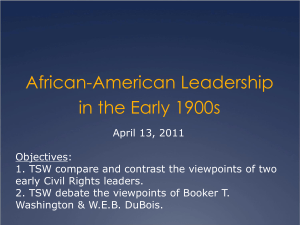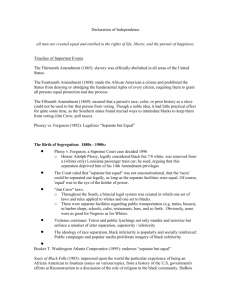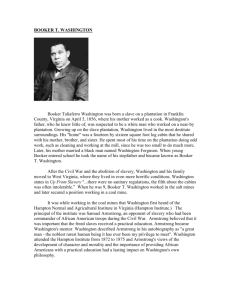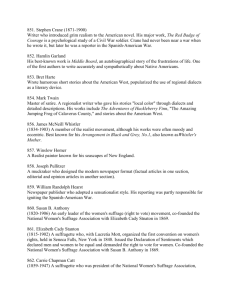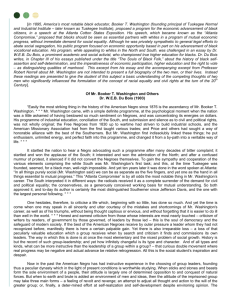The Evolution of Black Leadership at the turn of the Twentieth Century
advertisement
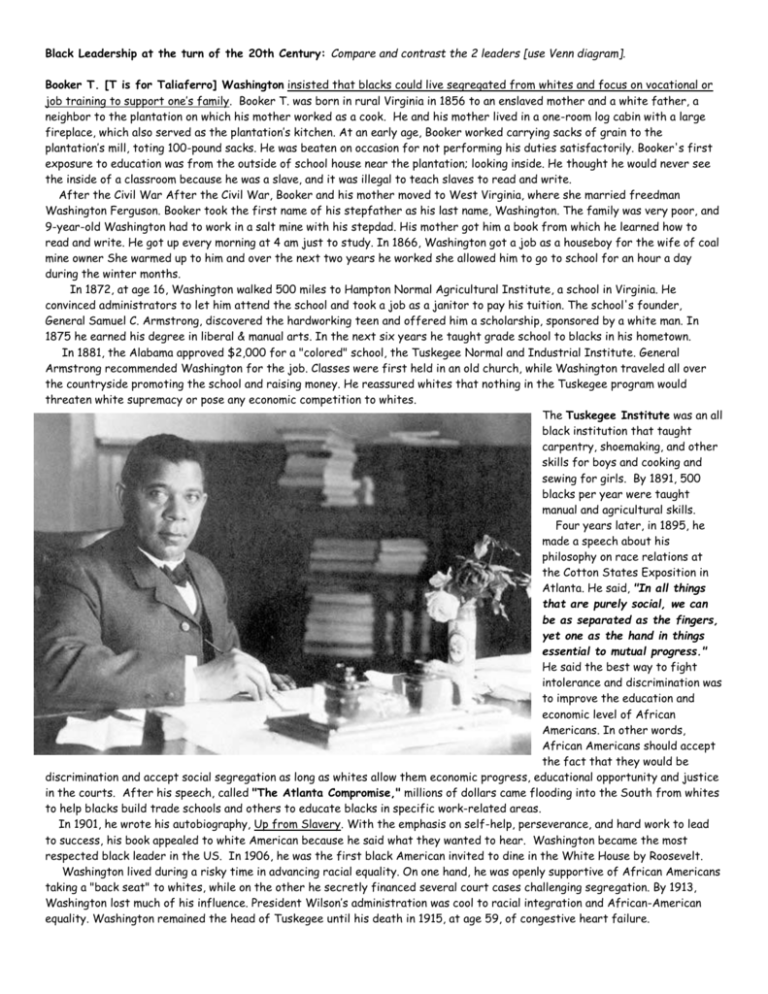
Black Leadership at the turn of the 20th Century: Compare and contrast the 2 leaders [use Venn diagram]. Booker T. [T is for Taliaferro] Washington insisted that blacks could live segregated from whites and focus on vocational or job training to support one’s family. Booker T. was born in rural Virginia in 1856 to an enslaved mother and a white father, a neighbor to the plantation on which his mother worked as a cook. He and his mother lived in a one-room log cabin with a large fireplace, which also served as the plantation’s kitchen. At an early age, Booker worked carrying sacks of grain to the plantation’s mill, toting 100-pound sacks. He was beaten on occasion for not performing his duties satisfactorily. Booker's first exposure to education was from the outside of school house near the plantation; looking inside. He thought he would never see the inside of a classroom because he was a slave, and it was illegal to teach slaves to read and write. After the Civil War After the Civil War, Booker and his mother moved to West Virginia, where she married freedman Washington Ferguson. Booker took the first name of his stepfather as his last name, Washington. The family was very poor, and 9-year-old Washington had to work in a salt mine with his stepdad. His mother got him a book from which he learned how to read and write. He got up every morning at 4 am just to study. In 1866, Washington got a job as a houseboy for the wife of coal mine owner She warmed up to him and over the next two years he worked she allowed him to go to school for an hour a day during the winter months. In 1872, at age 16, Washington walked 500 miles to Hampton Normal Agricultural Institute, a school in Virginia. He convinced administrators to let him attend the school and took a job as a janitor to pay his tuition. The school's founder, General Samuel C. Armstrong, discovered the hardworking teen and offered him a scholarship, sponsored by a white man. In 1875 he earned his degree in liberal & manual arts. In the next six years he taught grade school to blacks in his hometown. In 1881, the Alabama approved $2,000 for a "colored" school, the Tuskegee Normal and Industrial Institute. General Armstrong recommended Washington for the job. Classes were first held in an old church, while Washington traveled all over the countryside promoting the school and raising money. He reassured whites that nothing in the Tuskegee program would threaten white supremacy or pose any economic competition to whites. The Tuskegee Institute was an all black institution that taught carpentry, shoemaking, and other skills for boys and cooking and sewing for girls. By 1891, 500 blacks per year were taught manual and agricultural skills. Four years later, in 1895, he made a speech about his philosophy on race relations at the Cotton States Exposition in Atlanta. He said, "In all things that are purely social, we can be as separated as the fingers, yet one as the hand in things essential to mutual progress." He said the best way to fight intolerance and discrimination was to improve the education and economic level of African Americans. In other words, African Americans should accept the fact that they would be discrimination and accept social segregation as long as whites allow them economic progress, educational opportunity and justice in the courts. After his speech, called "The Atlanta Compromise," millions of dollars came flooding into the South from whites to help blacks build trade schools and others to educate blacks in specific work-related areas. In 1901, he wrote his autobiography, Up from Slavery. With the emphasis on self-help, perseverance, and hard work to lead to success, his book appealed to white American because he said what they wanted to hear. Washington became the most respected black leader in the US. In 1906, he was the first black American invited to dine in the White House by Roosevelt. Washington lived during a risky time in advancing racial equality. On one hand, he was openly supportive of African Americans taking a "back seat" to whites, while on the other he secretly financed several court cases challenging segregation. By 1913, Washington lost much of his influence. President Wilson’s administration was cool to racial integration and African-American equality. Washington remained the head of Tuskegee until his death in 1915, at age 59, of congestive heart failure. William Edward Burghardt Du Bois (1868 - 1963) was an American civil rights activist, sociologist, educator, historian, writer, editor, poet, and scholar. He left the US and became a naturalized citizen of Ghana in 1963 at the age of 95. The most vocal critic of Booker T. Washington was W.E.B. DuBois, born in Great Barrington, Massachusetts where he grew up in this all-white community. In 1884 he graduated as valedictorian from high school. He earned his college degree from Fisk University in Nashville, Tennessee in 1888, spending his summers teaching in all-black schools in Nashville's rural areas. In 1888 he entered Harvard as a junior, earned another degree cum laude in 1890. He earned his masters degree there in 1891 and became the first African American to earn a doctorate degree from Harvard in 1895. From 1892 to 1894 he also took graduate courses in history and economics at the University of Berlin. Du Bois' work was a mixture of scholarship and protest activity. His efforts were geared toward gaining equality for black people in a world dominated by whites and toward presenting evidence to refute the myths of racial inferiority. In 1903, he published The Souls of Black Folks, a book on African American culture and race relations. The book examined the tortured souls of blacks. He used the book to criticize Washington and insisted that blacks resist any erosion of their civil rights and demand equality. In 1905 he was the founder and general secretary of the Niagara Movement, an African American protest group of scholars and professionals, who laid out demands for racial justice. He fought for: full male suffrage; an end to discrimination in public accommodations; and the right to walk and talk freely. The movement was short lived but it set up the foundation for DuBois’ most lasting contribution in 1909, the NAACP, the National Association for the Advancement of Colored People. The NAACP included members of all races and religions. From 1910 to 1934 Dubois served as director of publicity and research and editor of The Crisis, its monthly magazine. Dubois and reporter, Walter White [a man who was 7/8th white and 1/8th black], fought to end lynching by publicizing the number of lynchings going on in America daily. The almost daily lynching of blacks throughout the South was escalating. From 1882 to 1928, 3397 blacks were lynched in the US. With the help of DuBois, these murders of innocent blacks were brought to the forefront of the nation. As a result, the number of lynchings in the 1930s declined but lynchings still existed. Dubois was sickened by Washington’s ideas in his Atlantic Compromise. In his newspaper, The Crisis, he wrote, "Mr. Washington distinctly asks that black people give up, at least for the present, three things--First, political power. Second, insistence on civil rights. Third, higher education of Negro youth." Dr. DuBois insisted blacks attain a higher education. He reasoned that success for African Americans depended on this. For many African Americans in the era from 1910 through the 1930s, Du Bois was the voice of the black community. He attacked President Woodrow Wilson when he allowed his cabinet members to segregate the federal government. He continued to fight against the demand by many whites that black education be primarily industrial and that black students in the South learn to accept white supremacy. Define: Booker T. Washington Tuskegee Institute Atlanta Compromise W.E.B. Dubois Niagara Movement NAACP The Crisis OPINION: Which of these men had the right approach to getting whites acclimated to the presence of free blacks in society? Answer the question based on the facts in the biographies above and the summary below…DO NOT PLAGIARIZE Summary: Washington’s significant advancements were achieved for and by blacks. Under his leadership, Tuskegee became a leading school in the country. At his death, it had more than 100 well-equipped buildings, 1,500 students, a 200-member faculty teaching 38 trades and professions, and a nearly $2 million endowment. Washington taught that economic success for African Americans would take time, and that subordination to whites was a necessary evil until African Americans could prove they were worthy of full economic and political rights. In contrast, DuBois’ push for higher education brought about an explosion of black youth going to college. The NAACP, became the most influential organization in bringing about positive change and was essential in desegregating schools in 1954. But in the 1950s, DuBois was rejected by the organization he founded because he embraced socialism/ communism during a time when communist Soviet Union was enemy #1 in the US. He left the country and moved to Ghana. He gave up hope that racial equality would ever be achieved in the US. Ironically, he died in Africa, the day before Dr. Martin Luther King, Jr. proclaimed “I Have a Dream” on the steps of the Lincoln Memorial in Washington, DC in front of 250,000 civil rights activists and supporters of different races, religions, and ethnic origins.


